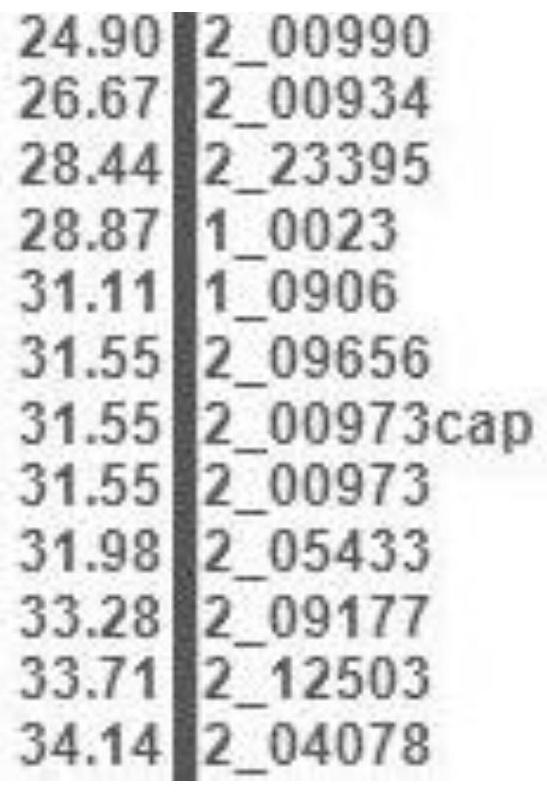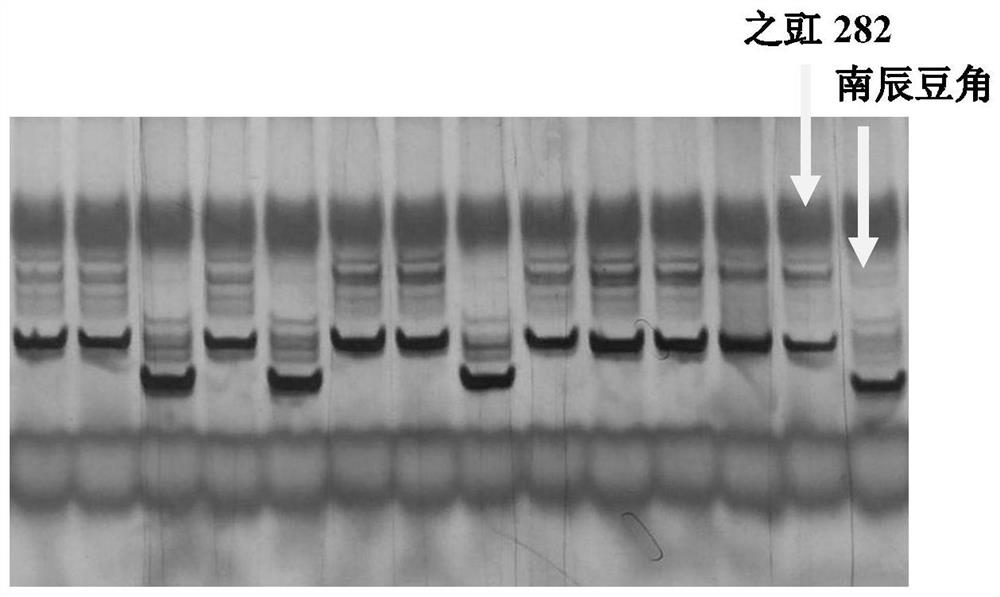Caps Marker Closely Linked with Cowpea Rust Resistance Gene and Its Application
A rust-resistant and marker technology, applied in the field of CAPS marker, can solve the problems of rust-resistant assisted breeding of molecular markers linked to rust-resistant genes that have not yet been reported, and achieve the effects of improving breeding efficiency and saving manpower and material resources.
- Summary
- Abstract
- Description
- Claims
- Application Information
AI Technical Summary
Problems solved by technology
Method used
Image
Examples
Embodiment
[0027] 1. Obtaining linked markers of rust resistance genes
[0028] (1) Population construction: using the rust-immune local variety "Nanchen Doujiao" (from the Vegetable Research Institute of Zhejiang Academy of Agricultural Sciences, No. ZN016) and the highly rust-susceptible variety "Zhi Cow 282", F 1 generation inbred, from F 2 From generation to generation, the strains were formed by continuous selfing for 7 generations in the way of single-grain inheritance, and a recombinant inbred line population containing 119 strains was constructed.
[0029] (2) Genotype and phenotype identification: The genomic DNA of the above population was extracted, and the genotype of the above population was identified using the new generation cowpea 51K SNP chip (Xu et al.2017) containing 51128 SNPs, and MSTmap (Wu et al. 2008) to build a linkage map; use a single rust physiological race Auv1 (from Zhejiang Academy of Agricultural Sciences), use the in vitro inoculation technique to identi...
specific example 1
[0041] The location of CAPS2_00973 on the genetic map of "Zhi cowh 282" x "Nanchen bean"
[0042] (1) Plant material: "Zhi cowh 282", "Nanchen bean" and "Zhi cowh 282" x "Nanchen bean" crossed F 7:8 A total of 119 recombinant inbred lines were generated.
[0043] (2) PCR amplification, enzyme digestion, and electrophoresis: extract the genomic DNA of the parents and 119 recombinant inbred lines in (1), and use CAPS2_00973 primers to amplify these materials. The PCR reaction volume is 12.5 μl, containing 10-20ng template DNA , 1×PCRbuffer (10mM Tris-HCl(pH8.3), 50mM KCl, 0.1mM dNTP, 0.75–1.5mM MgCl 2 , 0.2 μM primer, 1 UTaq polymerase. The PCR reaction program was pre-denaturation at 94°C for 3 minutes, denaturation at 94°C for 30 seconds, annealing at 55°C for 40 seconds, extension at 72°C for 40 seconds, 35 cycles, and finally a total extension at 72°C for 5 minutes, and storage at 4°C. Use NlaIII enzyme to digest the amplification product, the enzyme digestion system is 1...
specific example 2
[0046] Using CAPS2_00973 to screen high-generation breeding materials carrying rust resistance genes
[0047] (1) Plant material: use the rust-resistant parent "Nanchen Bean" as the female parent or male parent, and cross with several long cowpea varieties (lines) that have better agronomic characteristics but are not resistant to rust, and undergo multi-generational crossing and backcrossing , 29 high-generation breeding materials obtained after selfing.
[0048] (2) Anti-rust gene identification: Utilize the method (2) in the specific example 1 to extract the genomic DNA of 29 parts of high-generation breeding materials, use CAPS2_00973 primers to carry out PCR amplification, NlaIII digests the PCR product of 29 parts of materials and carries out electrophoresis, Assignment read tape. The results showed that 12 materials carried the specific band type of "Nanchen beans" ( image 3 ), indicating that it successfully bred the rust resistance gene from "Nanchen Bean". Natura...
PUM
 Login to View More
Login to View More Abstract
Description
Claims
Application Information
 Login to View More
Login to View More - R&D
- Intellectual Property
- Life Sciences
- Materials
- Tech Scout
- Unparalleled Data Quality
- Higher Quality Content
- 60% Fewer Hallucinations
Browse by: Latest US Patents, China's latest patents, Technical Efficacy Thesaurus, Application Domain, Technology Topic, Popular Technical Reports.
© 2025 PatSnap. All rights reserved.Legal|Privacy policy|Modern Slavery Act Transparency Statement|Sitemap|About US| Contact US: help@patsnap.com



